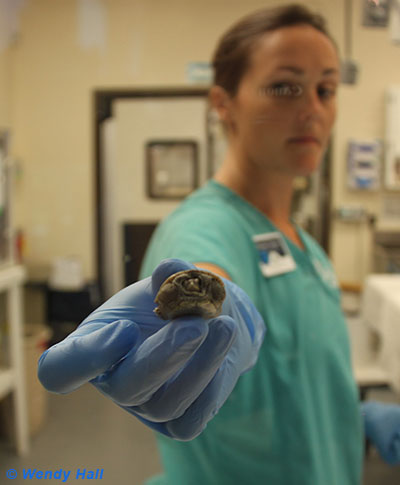
Moreover, the admission costs and the variety of gifts available in the shop are all quite reasonably priced, and they provide tours and special activities like educational programs and turtle nest walks. Sea turtles lay their eggs on the eastern beaches of the American continents, mostly the warmer latitudes, where the hatchlings emerge on their own and make their perilous way to the water, to spend years swimming some really remarkable stretches of ocean before returning to the beaches to lay their own eggs. Dwindling numbers of sea turtles worldwide, no small part of it caused by humans, has prompted programs to try and protect the populations we now have, and conservation efforts include monitoring nests to prevent damage and depredation by scavengers.
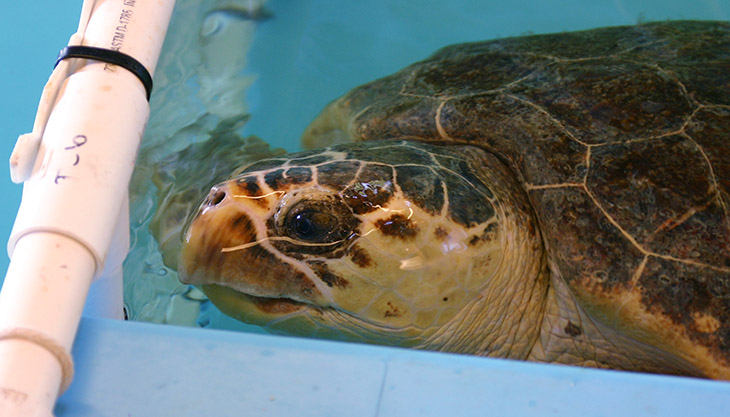
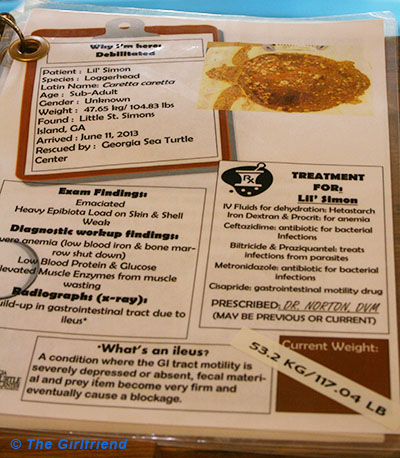 Places like the Georgia Sea Turtle Center also rehabilitate turtles injured by fishing gear, boat propellers, shark attacks, parasitic infestations, and even ingesting those ubiquitous goddamned plastic bags (which they mistake for jellyfish.) Lil’ Simon, above, was named after Little St Simon’s Island where he was found, the sister of our next stop that day. The Center provides charts in the rehab area that list the details of the patients, solely for the visitor’s curiosity, and the staff is always happy to answer questions from the public. There are even large mirrors above the tanks for better views of the patients – the place is exceptionally well thought-out. And since so much of the staff in wildlife clinics are volunteers, always let them know how much you appreciate their efforts and drop a few dollars (or a lot of them) their way. It’s money a hell of a lot better spent than chasing the latest stupid phones or big screen TVs.
Places like the Georgia Sea Turtle Center also rehabilitate turtles injured by fishing gear, boat propellers, shark attacks, parasitic infestations, and even ingesting those ubiquitous goddamned plastic bags (which they mistake for jellyfish.) Lil’ Simon, above, was named after Little St Simon’s Island where he was found, the sister of our next stop that day. The Center provides charts in the rehab area that list the details of the patients, solely for the visitor’s curiosity, and the staff is always happy to answer questions from the public. There are even large mirrors above the tanks for better views of the patients – the place is exceptionally well thought-out. And since so much of the staff in wildlife clinics are volunteers, always let them know how much you appreciate their efforts and drop a few dollars (or a lot of them) their way. It’s money a hell of a lot better spent than chasing the latest stupid phones or big screen TVs.
Of course, while at the Center, I took the opportunity to chase a brown anole (Anolis sagrei) that was displaying pompously on a bench. I could probably be in a medical clean room and still find creepy-crawlies to photograph…
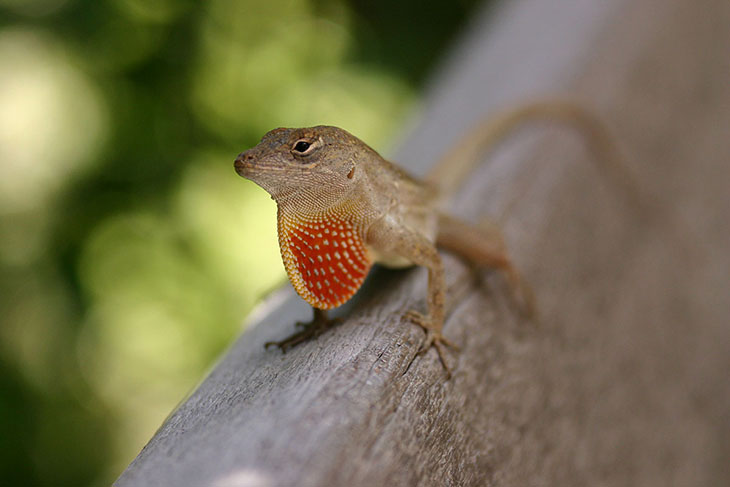
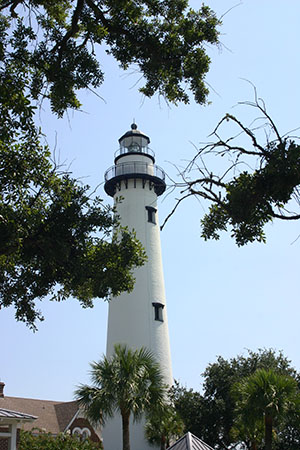 We headed north a short ways to St Simon’s Island, visible across the inlet from Jekyll, two of the many chunks of land separating the sea from the coastal wetlands that usually get the name “barrier islands.” There, we monkeyed around (seriously – I’m not showing you those pics) on a huge twisted old tree under the lighthouse, did a few portraits, and went for a swim in the inlet. I got some practice on my “block all the ugly unwanted details with foreground elements and cropping” techniques – the area surrounding the lighthouse was loaded with cars and signs – and I looked, once again in vain, for a decent place to do some snorkel explorations. We did the obligatory walk around the touristy areas of St Simon’s before heading back to Our Hosts’ Place outside of Savannah. Now, I probably could have amused myself for the week without leaving the property there, since they had a nearby pond with a lovely cypress swamp area, a beehive, and even some visitors (by now, you should know I’m not referring to humans with that.) They also had a Gator utility tractor that their dogs adored riding in, which we used for some exploring. The pond, alas, was too small to make an airboat viable – no southern swamps are complete without airboats.
We headed north a short ways to St Simon’s Island, visible across the inlet from Jekyll, two of the many chunks of land separating the sea from the coastal wetlands that usually get the name “barrier islands.” There, we monkeyed around (seriously – I’m not showing you those pics) on a huge twisted old tree under the lighthouse, did a few portraits, and went for a swim in the inlet. I got some practice on my “block all the ugly unwanted details with foreground elements and cropping” techniques – the area surrounding the lighthouse was loaded with cars and signs – and I looked, once again in vain, for a decent place to do some snorkel explorations. We did the obligatory walk around the touristy areas of St Simon’s before heading back to Our Hosts’ Place outside of Savannah. Now, I probably could have amused myself for the week without leaving the property there, since they had a nearby pond with a lovely cypress swamp area, a beehive, and even some visitors (by now, you should know I’m not referring to humans with that.) They also had a Gator utility tractor that their dogs adored riding in, which we used for some exploring. The pond, alas, was too small to make an airboat viable – no southern swamps are complete without airboats.

Unfortunately for me, what they also had, in great abundance, was fire ants. The red imported fire ant (Solenopsis invicta) is a particularly disreputable little shit that I am extremely well-accomplished in locating. I was diligent, this time around, in examining everyplace I walked for fire ant mounds, but this was a pointless exercise, since they simply had the run of the property and could be found everywhere without the faintest indication of their presence, at least until my feet began the familiar itching, burning sensation that heralds their displeasure at human presence. In summer I am either in sandals or barefoot, since my feet sweat profusely in anything more and even my sneakers become some kind of biohazard after a day. I was forced, eventually, to wear socks with my sandals, which horrifies the Fashion Police but no more than the oozing leprosy of my feet would have. Fire ants produce large, pus-laden or fluid-filled blisters, way out of proportion to their diminutive size, and the effects can last a ridiculously long time. Suffice to say I hate the little fuckers and am researching ways to hasten their extinction. I did make several attempts to photograph them in detail (managing not to get stung at those times, believe it or not,) but their movements are so rapid that I could not produce anything useful at all. Then I discovered that I had already gotten images of the same species dismantling a dead honeybee under the hive.

The honeybees, by comparison, were quite mellow and allowed a very close approach without taking the slightest issue, even during their busy times of the day. We were gifted some of Our Hosts’ honey harvest as well, fed by whatever wildflowers the bees had found nearby instead of the commercially-popular clover, and this lent it a buttery, faintly sharp flavor as if it had a hint of molasses – very nice! As a tiny bit of trivia about honey, it is a natural antibiotic and almost impervious to spoilage, and the Georgia Sea Turtle Center (among many other medical facilities) uses it to treat topical wounds since it coats well and doesn’t introduce contamination nor cause antibiotic resistance in bacterial strains.
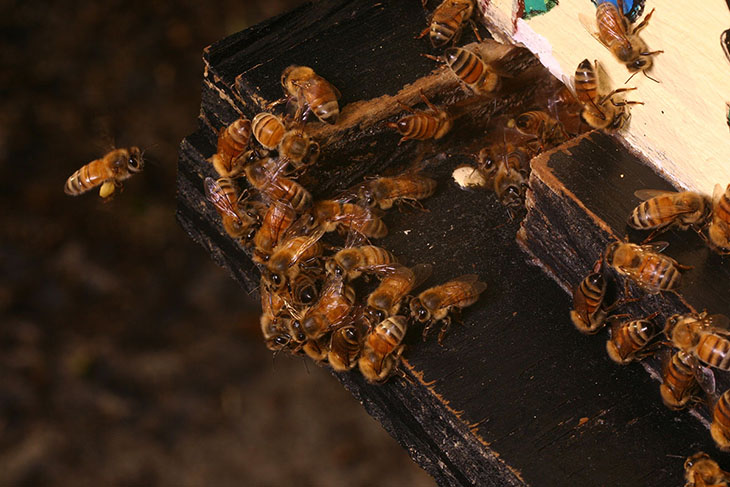
Yet, there was a distinctive something that Our Hosts could not provide, something that no trip to the subtropics should lack, so we did a short trip to the Savannah National Wildlife Refuge to find… gators!
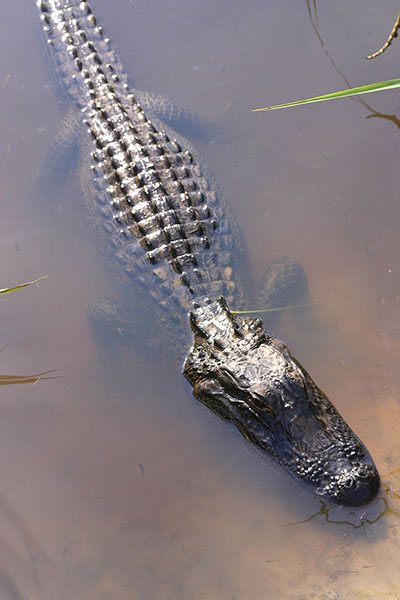 The Girlfriend’s Younger Sprog had never seen an American alligator (Alligator mississippiensis) except in zoos, and that certainly doesn’t count, so we had to ensure that she saw one in the wild, and the Savannah National Wildlife Refuge is a pretty sure bet. Naturally, she had to show us all up by being the first to spot one, and the largest one at that – she had a rotten vantage point in the back seat on the grassland side of the drive instead of looking over the channel, and still found a beaut. Unfortunately, the height of the grass and decorum over approaching one weighing well over 90 kg (200 lbs) meant we have no really snazzy pics of that one, so what you see here is my meager find, whose head is as long as my blistered foot – just a leetle guy (it must be a male, since Our Female Host kept informing us that he was a Good Boy.) If you look close you can see minnows sharing the water alongside.
The Girlfriend’s Younger Sprog had never seen an American alligator (Alligator mississippiensis) except in zoos, and that certainly doesn’t count, so we had to ensure that she saw one in the wild, and the Savannah National Wildlife Refuge is a pretty sure bet. Naturally, she had to show us all up by being the first to spot one, and the largest one at that – she had a rotten vantage point in the back seat on the grassland side of the drive instead of looking over the channel, and still found a beaut. Unfortunately, the height of the grass and decorum over approaching one weighing well over 90 kg (200 lbs) meant we have no really snazzy pics of that one, so what you see here is my meager find, whose head is as long as my blistered foot – just a leetle guy (it must be a male, since Our Female Host kept informing us that he was a Good Boy.) If you look close you can see minnows sharing the water alongside.
What was disturbing was that I spotted this one while the others had wandered elsewhere, did a few shots, and let it be, to find that it was gone when I returned with the others. However, it reappeared immediately and drifted right up to shore at my feet, obviously looking for a handout, which means assholes are going against all recommendations there and feeding the gators. Having alligators associate humans with food is quite obviously a bad idea, but too few people seem able to grasp positive reinforcement (or any kind of animal behavior,) which is one of the many reasons why I push critical thinking so much.
It should be noted that the Refuge’s Visitor Guide actually recommends letting a friend know where you had gone. Not just due to the alligators, but also because the trails are long, unshaded, lacking water, and bordered by swampland, mud, and open channels. People tend to think anyplace welcoming visitors is therefore safe, but this is true wetlands, which is challenging terrain to tackle unprepared. A car can handle the wildlife drive easily, but anyone hiking or bicycling should be prepared for demanding conditions.
And of course, alligators…

This one’s not as big as it looks – I just used a long lens – but I liked the effect overall. I saw the sun shining on that slit pupil and had to go for this composition. You did not miss the minnows here too, I’m sure.
And a last quick note, before I close this post to and start another, where we actually got into the city of Savannah. Upon getting back, The Girlfriend almost immediately left on another trip, returning just today. While away, she found something that reminded her irresistibly of me, and had to get them. What did she find, this love of mine?
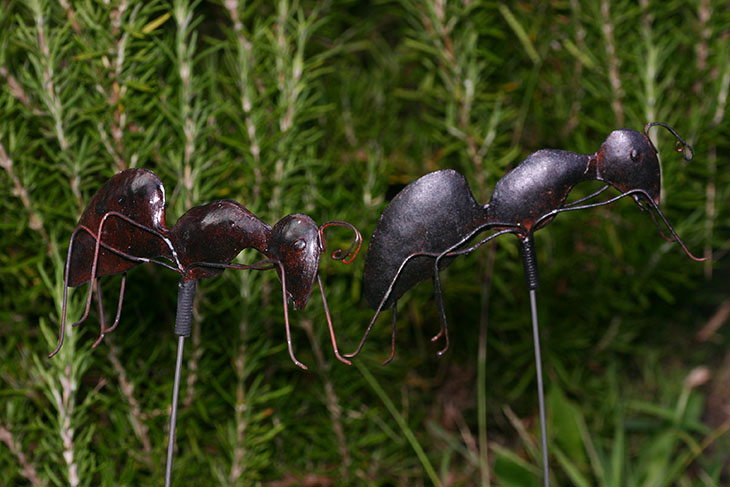
Great.





















































Nice job! Love the Ants! What r they! Lawn ornaments! Lol! 2 funny :)
I should probably warn you, you’re two strikes down on the “lol” rule – I don’t want to have to ban you.
The ants are, um, knickknacks I guess. Need to find a shelf to put them on…